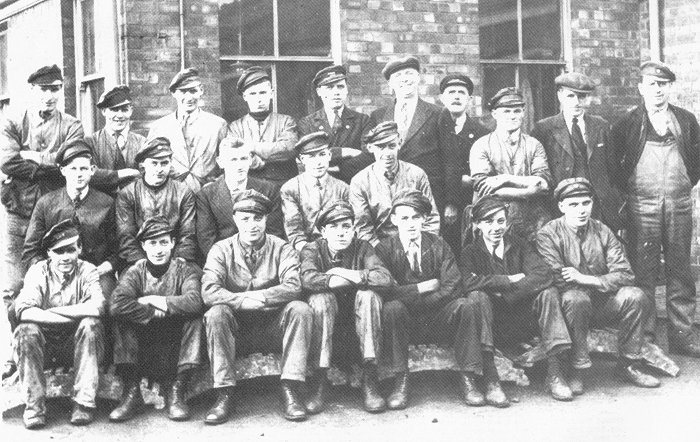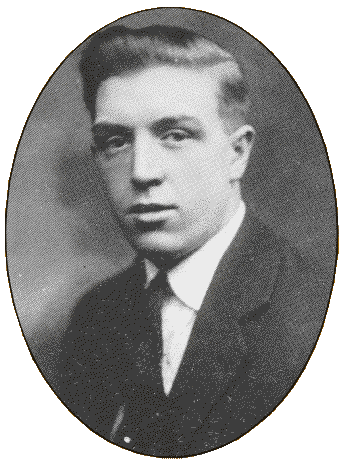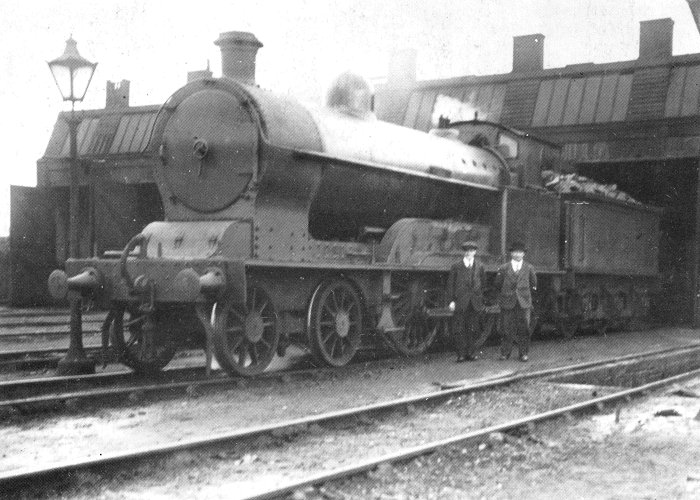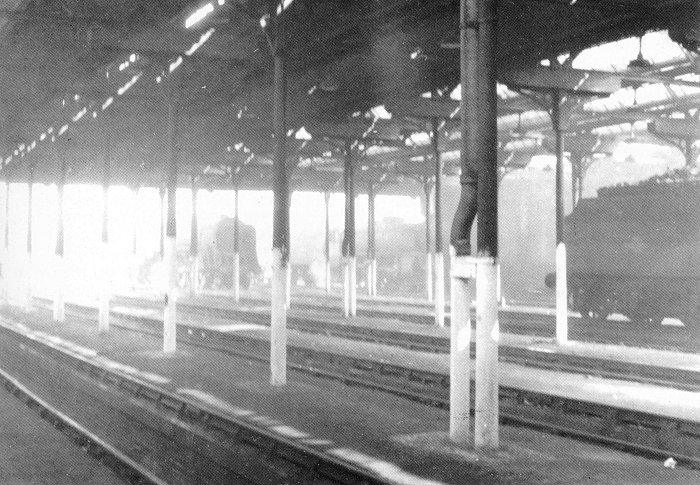Working at Bushbury Shed
This is an article that was in two parts. The first part was in edition 1
and part 2 was in edition 2.
The L.N.W.R. built a shed at Bushbury as early as 1859, replacing the
first structure with something more substantial in 1883. The new shed
was doubled in capacity, holding 24 engines, but was still not large
enough. Bushbury was always overshadowed by the Great Western presence
at Stafford Road, only a short walk away. It had its own distinctive
atmosphere though, and has been aptly described as "a family shed", and
so it was, with fathers, sons and uncles all working together.
The same surnames appear in Bushbury, marked "railwayman" as far back
as the 1881 census, probably working at the earlier shed on the same
site. Moving on was a fact of life for Great Western men in search of
promotion, Wolverhampton for instance became home for many ex-Cambrian
and Taff Vale railway men, but life at Bushbury was more predictable and
the order of things changed little over the years.
The enlightened attitude of the G.W.R. towards such things as social
amenities and pensions for ordinary employees is well known. The
L.N.W.R. was less forthcoming in such matters and the working conditions
at Bushbury were not of the same standard, with a corresponding lack of
after work activities. What the men had they provided for themselves.
Alexander Staveley Hill, the Conservative M.P. built a school for the
children of Bushbury which opened in 1880, most of the students being
the sons and daughters of railway men. This school later served as the
venue for small concerts organised by the L.N.W.R. employees at
Bushbury.
|

Bushbury timekeeper Sid Newill stands before
"19 inch" goods 4-6-0 No. 8717 (c. 1930). These engines were used on
the "double home" trips to Liverpool. These 4-6-0s were replaced in
the later 1930s by 'Super D' 0-8-0s, but their old duty was still
known as the "19 inch link". Photograph courtesy of Joyce Batchelor, Nee Newill. |
| For instance in September 1892 the Bushbury Loco
Sick Society, twenty pounds in the red due to the recent flu
epidemic, ran a series of concerts and choral works there, the
entertainments being provided by the newly formed "railway glee
class". In 1897 the first of the "Bushbury Railway Servants" Annual
Concerts took place, the venue over the years usually being the
assembly rooms of the Electric Construction Company in Showell
Lane. The proceeds were always in aid of the "Railway servants'
Widow and Orphan Benevolent Funds". In 1906 for instance the
entertainment included "Songs of a sentimental character" such as
"Dear Heart" by Miss Kate Harper, and "The Village Blacksmith" by
Mr. Frank Thorne. Mr. Sam Cotton was assisted in his songs, monologues and sketches,
"amidst much laughter" by "Miss Gerty William's comic effusions". There
was a pension scheme of sorts provided by the company, costing the
member in later years 6d, but with no provision for his wife or children
in the event of an accident. This scheme was scrapped by the L.M.S., who
instituted their own Superannuation Fund, which provided also for the
railway man's family from 1938 onwards. The Bushbury men had their own Welfare Club which
ran an annual trip to Blackpool, the "L.M.S. Magazine" for 1938
reported that "100 members, accompanied by their wives and families,
enjoyed a well organised trip in fine weather". |

Bushbury engine driver Walter (Dick) Charman
was born in Bushbury Lane and is seen here around the turn of the
century. His brilliant blue eyes, for which he was noted, are
apparent even in the photograph, loaned from the family album of
Joyce Batchelor. |
It was the Bushbury
men who began what became a system wide preoccupation when they
instigated the "L.N.W.R. Flower and Vegetable Show" at Bushbury in
1919.
In 1922 there were 750 participants, 200 more than the
previous year, displaying their procreations under a marquee at
Oxley Manor Park Estate. Additional fun and entertainment was
provided by the perriots, competitions, sports, dancing and the
"Bescot Silver Prize Band".
There was a cricket team, who played on
an allotment near to Bushbury Junction, complete with an old railway
carriage to change in. A proper pitch was later used at Tremont
Street. Football too was played, using the excellent ground behind
the Star motor works.
The "Mutual Improvement" classes held meetings
at the old station near to the shed, with visiting lecturers
explaining the workings of the steam engine. One of the drivers made
a working wooden model of the Walschaerts valve gear, in his own
time, to help novices understand its mysteries better. |

"George the Fifth" class 4-4-0 No. 5329
"Queen Mary" stands ahead of the water tank at Bushbury Shed, circa
1929. Water for the tank came from the company's own pumping station
at Wood Lane. If the level in the tank fell low it was then
replenished from the town supply. The amount used being duly
recorded on a water meter and later charged to the company.
Photograph: Joe Hancock. |
| The Great Western, unknowingly, provided the Bushbury men with their
swimming facilities. They would creep off to Bushbury pool under cover
of darkness and use the diving board, swimming out to the raft of
barrels moored in the middle, all provided by the G.W.R. Institute at
Stafford Road! Finally the men of Bushbury made it on to the B.B.C.
Radio when listeners to "Childrens hour" heard the commentator take them
from Wolverhampton to London on a "2 hour express". Many adults must
have learned with surprise of the forgotten heroes of Bushbury who ran
the Birmingham to London expresses! These "forgotten heroes" were part of the Bushbury scene, coming and
going along Bushbury Lane with their wicker baskets containing their
"snaps", ascending and descending the stairway that led down from the
railway bridge to the shed. Until the 1950s this stairway was the only
means of entrance to the shed, and occasionally a company detective
would be waiting beside the gas lamp at the top of the stairs to search
the men as they came off their shifts.
Often the first job given a youth at the shed was that of "caller up",
when he would walk on the "short distance" turn, or ride a solid-tyred
bicycle on the "long distance", which covered an area of many miles.
From this he would progress to cleaning, working with a gang of five or
so others on one engine at a time. Red wax was kept for engines such as
'Westminster" in its crimson finish, black for the "blackberry black"
and vaseline or black oil for the smokeboxes. Two hours were allowed for
the bogies, drivers and side rods on the one side, but they had to be
clean on both sides of the wheel or side rods or you did it again. |

Bushbury Stalwarts, 1938. Those known are
as follows (left to right):
Back Row: J. Fellows, D. Wiltshire, N. Lloyd, E. Murray,
R. Cripps, S. Newill, H. Simms, R. Kerry, F. Andrews (Foreman
Cleaner), and J. Ford.
Middle Row: J. Moore, J. Sharp, N. Golding (Shed Master),
? and W. M. Burgess.
Front Row: R. Bownes, H. Jones, ? V. Haller, E. Nicholls,
J. Ballinger, and B. Hayford.
Those sitting on the front row are on wooden formers that were
used to build the brick arch in the firebox. Photograph courtesy
of J. Batchelor. |
| One of the less pleasant aspects of cleaning was the occasional suicide
or dead animal whose remains had been left splattered beneath the
engine, dried hard against the firebox. One driver on the London turn
had run down seven suicide victims in his time.
By British Railways
days, from 1956 or 1957 onwards the, cleaning went "to the wall". A boy
would be "passed cleaner" at 17 and used more often firing than
cleaning, on local turns.
There were the bar layers, Steam raisers,
washing out, all the usual engine shed activities. Washing out was
casual to say the least in L.N.W. days, with often one plug only being
removed and the others ignored. With the tightening up introduced by the
L.M.S. the job had to be done properly, but the heads of the washing out
plugs would often strip rather than unscrew they were furred in so
tightly. As Alfred Brough recalled, it was a wonder they steamed at all! |

Alfred Brough as a young man. Alf' put in
twenty years of hard work at Bushbury. Needless to say these were
not his working clothes!
Courtesy of Alfred Brough. |
| The worst jobs were fire dropping and coaling. The fire droppers would
empty the ashes from the smokebox, but the wind would cause them to
explode into flames in the man’s face. To this day Alfred Brough has no
eyelashes, which he puts down to this. The fire droppers could tell a
bad driver by the glowing smokebox and the paint blistered off part way
up the smokebox, then they knew that they were in trouble. Coaling was a shattering job, the coal wagons being emptied by hand as
piece work. The coalers could earn more money than the timekeeper or the
top link drivers, but Joe Hancock remembers the effect the work had on
them, he would see them staggering along the lane at Bushbury, holding
the railings for support. Alfred Brough recalls that his hands were so
calloused that a sixpence would fit into the cracks edge, on!
The coalers were paid 4½d per ton if the coal wagon was 4’ 2"
or under, 6d per ton if it was over that height. They would throw the coal over the top of the wagon into the tender by
guess work as they dug lower and lower into the coal (L.N.W. coal wagons
having no side doors were unloaded from the top down, a tough job.).
Bushbury engines used three grades of coal. "Dalton" being the best, for
the London expresses. The men called it "sun coal" because it would
burst instantly into flame "like the sun". |

An unknown "Experiment" class
4-6-0,
believed to be "City of Liverpool" (L.M.S. number 5460) stands
before the main shed building in the 1930s. The shed follows the
standard L.N.W.R. design, notice the open doors to the left and the
original northlight roof. In the foreground are
Foreman Cleaner
Frank Andrews and Shed Foreman Longstaff in his black bowler.
Courtesy of Joyce Batchelor/Ted Talbot. |
| "Cresswell" was used for the heavy freight engines,
and "Littleton" cobbles, the common coal. In winter the coal would
freeze together, the men would struggle shovelling the frozen
Littleton Cobbles into one engine, coal up two London engines with
Dalton and return to the Littleton coal to find it frozen solid
again!
The pay varied around £3 working mornings,
£4-10-0 working
afternoons and £5-5-0 on nights for a 48 hour week, a top driver
earned about
£4-10-0 per week. This all ended with the introduction
of the automatic coaling plant, when the coalers rates plummetted to
£2-10-0. Alf left Bushbury as the war came and found himself "in
clover" earning £5-17-0 per week immediately!
|

Bushbury shed staff take part in a tug of
war in the late 1930s. Almost every family in Bushbury had a railway
connection in those days.
Courtesy of Joyce Batchelor. |
| Inside the shed were four baulks of timber meeting
in an apex in the shed roof. Coming down from this was a hydraulic
lift worked by a steam pump in the corner. Thus a limited amount of
maintenance work could be carried out at the shed. The bogies of an
engine could be run out clear and such things as piston glands, rivetting or adjustments to the motion attended to. Boilersmiths
were on hand to seal any leaking tubes or attend to minor problems.
Brakes were adjusted constantly, the goods engines being set
somewhat slacker than the expresses. Spare parts for the repairs
came from Bescot or Crewe. The spares would arrive as a parcel at
Wolverhampton where they would be collected and taken to Bushbury on
the front of an engine. From L.M.S. days the stores kept a set of
tools, a bucket and a fireman’s shovel for each engine, but prior to
this it had been a case of grabbing what was available.
One driver known as Frank Huband carried his own piece of equipment
when working on the "Super Ds", for he was too short to reach the,
whistle, "so being a British working man, he put a piece of string on it
and worked it like that"! This compares favourably with the stay of the
little Welshman at Stafford Road who drove the "King" class expresses to
London standing on a bucket to reach the controls.
Friendly rivalry between the men of Bushbury and their ex Great Western
counterparts continued long after nationalisation. In the late 1950s the
young Bushbury cleaners would sneak into Stafford Road and dirty up an
engine, just tidied by their rivals. One young cleaner transferred from
Stafford Road to Bushbury, and when asked why, remarked with a sly grin,
"Well, if you can't beat ‘em, you may as well join ‘em!"
|

An interior view of Bushbury
shed in later days, showing the replacement roof. The roof replaced
the standard L.N.W.R. 'northlight' structure. The opportunity was
taken to raise the whole roof on blocks (clearly shown in the
picture) in anticipation of the future storage of electric
locomotives. Nothing came of this idea and the shed closed in April
1965. Photograph courtesy of Tom Booth. |

|
|
 |
|
 |
Return to
Edition 6 |
|
Return to
the Beginning |
|
Proceed to
Stourbridge Jcn. |
|